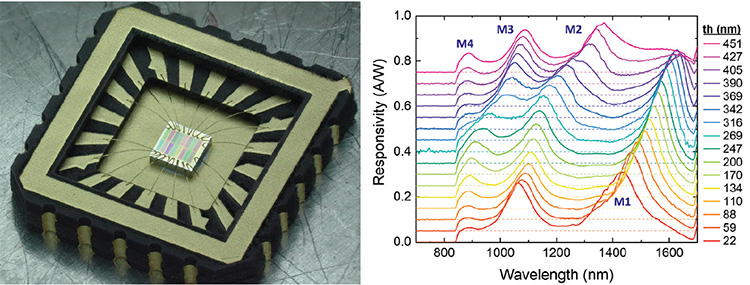 Left: Spectral-sensor chip wirebonded for electrical read-out. Right: Measured responsivity for 16 pixels of the same array, with measured tuning-layer thickness increasing from 22 to 451 nm. Resonant modes are indicated by M1 to M4. An offset, with increasing steps of 0.05 A/W, is added for clarity. The zero-responsivity axis for each curve is indicated by the dashed line in the corresponding color. [K.D. Hakkel et al. Nat Commun. 13, 103 (2022)]
Left: Spectral-sensor chip wirebonded for electrical read-out. Right: Measured responsivity for 16 pixels of the same array, with measured tuning-layer thickness increasing from 22 to 451 nm. Resonant modes are indicated by M1 to M4. An offset, with increasing steps of 0.05 A/W, is added for clarity. The zero-responsivity axis for each curve is indicated by the dashed line in the corresponding color. [K.D. Hakkel et al. Nat Commun. 13, 103 (2022)]
Optical spectroscopy has been used for decades to classify materials and measure their composition. Traditional benchtop spectrometers, while providing high resolution and wide spectral range, are bulky and contain moving parts. The need for in-situ and field sensing has recently driven a quest for spectral sensors with reduced footprint, increased portability and lower cost, which can potentially extend their application to consumer markets and even smartphones.1 Enabling such applications requires chip-level integration and mass manufacturing using semiconductor processing methods.
While substantial progress on integrated spectral sensors has been made in the visible spectral region and up to 1100 nm,2 progress has been limited in the region from 1100 to 1700 nm, which is particularly interesting for applications in agri-food and health care. In pursuit of a simple and robust solution, we have recently developed a fully integrated near-infrared (NIR) sensor based on an array of 16 resonant-cavity-enhanced photodetectors operating in the 850-to-1700-nm wavelength range.3
Each pixel of our array contains a thin absorbing layer inside a Fabry–Pérot cavity, resulting in a strong spectral dependence of the quantum efficiency. The spectral response is tuned individually by changing the effective optical path of the cavity system, which allows the spectral range of interest to be covered. We used InGaAs membrane-on-silicon technology to fabricate the detector, which displayed spectral peaks with linewidths of 100–200 nm and high responsivities of up to 0.36 A/W, enabling a high signal-to-noise ratio in sensing experiments.
We further showed that the photocurrents produced by the detectors can be directly used as input to a regression model, without any intermediate step of spectral reconstruction. This marks a paradigm shift from “spectrometry” to “spectral sensing,” focusing on sensing performance rather than on device parameters such as spectral resolution.
As a proof of principle, the array has been used in several sensing experiments. We have determined the fat content of milk with high accuracy, indicated by a coefficient of determination R2 = 0.942. This is a relevant problem as it impacts the economic value of milk. We also used the sensor array to classify different plastic types (potentially useful in waste sorting), and demonstrated its possible application in the identification of illegal drugs.4
We expect that our platform can achieve high sensing performance for a wide range of organic and inorganic materials. Most biochemical quantities of interest—such as sugar, starch, fat and protein—produce relatively broad spectral signatures, and can be detected using an array-based spectral sensor with limited resolution. We thus believe that our results enable a major step in the miniaturization of spectral sensors, a platform that provides a solution for many quantification and classification problems in which minimizing the complexity, size and cost of the sensors is critical.
Researchers
Kaylee D. Hakkel, Maurangelo Petruzzella, Fang Ou, Anne van Klinken, Francesco Pagliano, Tianran Liu, Rene P.J. van Veldhoven and Andrea Fiore, Eindhoven University of Technology, Eindhoven, Netherlands
References
1. Z. Yang et al. Science 371, abe0722 (2021).
2. R.A. Crocombe. Appl. Spectrosc. 72, 1701 (2018).
3. K.D. Hakkel et al. Nat Commun. 13, 103 (2022).
4. R.F. Kranenburg et al. Talanta 245, 123441 (2022).
